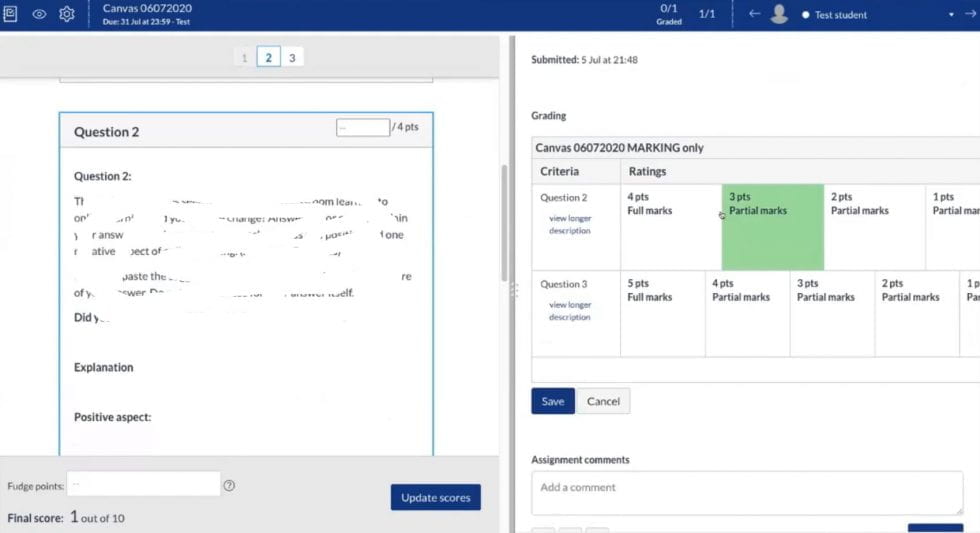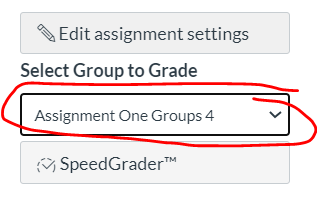Canvas SpeedGrader and multiple markers
SpeedGrader is Canvas’ built-in marking tool. If you are unfamiliar with using it, these guides will help.
On this page
How-to-guides
Important: The Grade Posting policy in the Canvas Gradebook for the assessment should be set to ‘Manually’ so the grades are not visible to students until they are ready to be released. See our FAQ on hiding grades.
Video: Our in-house digital learning specialist, Karl McGuirk, steps us through the Canvas’ Gradebook and SpeedGrader. This video is presented in Panopto. Sign in to watch the video with your University of Auckland credentials.
Video – Dr Lindsay Diggelmann (Associate Dean for Teaching and Learning – Faculty of Arts) talks about submitting assignments, and marking in SpeedGrader.
Anonymous grading
Hiding student names from markers and vice versa
A common question among teachers is how to suppress the names of student submissions in SpeedGrader? This is particularly relevant in courses that use multiple markers for grading assignments, to avoid the suggestion of bias or favouritism.
This recorded drop-in session held in 2020 demonstrates the settings in Canvas that enable anonymous marking.
See also, the Instructor guides for:
- Names of student submissions can be hidden in SpeedGrader.
- Anonymous grading can be enabled when setting up a Canvas Assignment.
Note: Submissions containing identifying information will still be visible, e.g., assignment cover sheets. Also, if markers use the ‘Assignment comments’ feature in SpeedGrader, the comment will include the marker’s name. Markers may use the annotations feature instead, to add an anonymous comment to the submitted document.
Multiple markers
Grading with multiple markers
Some assessments require multiple markers using SpeedGrader. However, if more than one marker is working on the same student’s submission at the same time, the first assigned grade can be overridden when the last entered grade is saved. To avoid this, we recommend these methods of marking.
- Split the total number of assessment submissions between multiple markers. Each marker is given a portion of the total number of assessment submissions and grades the entirety of each submission.
- Grade specific questions within assessment submissions. Each marker grades a particular question across multiple submissions (also known as ‘strip marking’).
Splitting the total number of assessment submissions between multiple markers
Clear communication between markers is key to ensuring only one marker is grading a student’s submission in SpeedGrader at a time to avoid marks from being overridden. You may wish to create a timetable or spreadsheet for markers to divide up and schedule marking on student submissions. If you have a small number of markers who can set aside specific times for marking, this can be an easy low-tech way of handling this.
If you have a larger number of markers to co-ordinate, or markers whose availability times are difficult to predict or clash with each other, we recommend you use these methods:
For Canvas Assignments and Quizzes
Course co-ordinator or main lecturer:
- Create Group Sets to divide your class into groups for each marker.
- Change your course settings to launch SpeedGrader Filtered by Student Group. This forces markers to select the group they are assigned to mark before launching SpeedGrader.
Note: These settings can be done after students have completed their assessments before you start marking.
Markers:
When marking a Canvas Assignment, launch SpeedGrader Filtered by Student Group. This will let you choose which group you will mark.
When marking a Canvas Quiz:
- To mark your student group submissions, you need to select your student group in the Gradebook. Go into the Gradebook by clicking on Grades on the left hand navigation menu. Filter the view by Student groups (View > Filters > Student groups) and select the Student Group in the drop-down menu.
- Go to the quiz you want to mark and open up SpeedGrader to start marking. Only the quiz submissions from your student group should come up.
- If you need to mark a different student group, go back to Gradebook to choose the appropriate student group. (To go back to Gradebook from SpeedGrader, click on the icon on the top left).
Watch this video of a recorded drop-in session, held in 2020, which demonstrates the settings in Canvas that enable Group Sets within SpeedGrader.
Video – Chun Li demonstrates student groups in SpeedGrader. Opens in Panopto. Sign in to watch the video with your University of Auckland credentials.
Using multiple markers to grade specific questions across multiple submissions
Some assessments require multiple markers, where each marker is assigned a specific question to grade across multiple submissions. Issues can arise in Canvas SpeedGrader if multiple markers are grading the same submission at the same time (for different questions), with only the last entered grade being saved.
Clear communication between markers is key to ensuring only one marker is grading a student’s submission in SpeedGrader at a time to avoid marks from being overridden. You may wish to create a timetable or spreadsheet for markers to divide up and schedule marking on student submissions. If you have a small number of markers who can set aside specific times for marking, this can be an easy low-tech way of handling this.
If you have a larger number of markers to co-ordinate, or markers whose availability times are difficult to predict or clash with each other, we recommend you use these methods:
For Canvas Assignments
Course-coordinator or main lecturer:
Set up Rubrics Grading by Question (UoA Toolbox) in your live course before starting marking.
Markers:
Access SpeedGrader by going through Rubrics Grading by Question (UoA Toolbox) to avoid overriding marks. They must not work on the same student at the same time.
For Canvas Quizzes
While you can Grade by Question in Quizzes (beta) to do strip marking in classic Quizzes, this introduces the risk of marks being overridden if more than one marker works on the same student submission at the same time (while grading different questions). If you have a small number of student submissions and/or markers who you can co-ordinate easily, the risk can be managed with clear communication between markers and setting up a timetable for markers to work on submissions.
We recommend you use Rubrics Grading by Questions (UoA Toolbox) for Quizzes.
Course-coordinator or main lecturer:
Set up Rubrics Grading by Question (UoA Toolbox) in your live course before starting marking.
Markers:
Access SpeedGrader by going through Rubrics Grading by Question (UoA Toolbox) to avoid overriding marks. They must not work on the same student at the same time. Note that grades need to be manually entered to the grade field while marking because just clicking on the appropriate box on the rubric does not automatically enter it into SpeedGrader.
Note: Rubrics Grading by Question can’t be filtered by student groups. If you have strip marking that requires submissions to be split amongst markers, we recommend you set up a spreadsheet and/or timetable to organise when markers grade (using Rubrics Grading by Question) so you don’t risk overwriting grades.
FAQs
SpeedGrader is too slow to use for large classes, what can I do?
SpeedGrader pre-loads all assignment/quiz submissions, therefore large classes can be unwieldy.
We suggest splitting your class into smaller groups using the Groups feature in Canvas (you will find that under the People page). Create a Group Set and name it according to the Assignment or Quiz. When creating or editing the Assignment/Quiz, select the Group Set that you just created. This does not mean that students will work in groups to submit the Assignment/Quiz, it’s just to make SpeedGrader more manageable.
Then in SpeedGrader, filter the submissions Group by Group. This will load much smaller batches of Assignment/Quiz submissions and SpeedGrader should be much more responsive.
Can multiple markers use SpeedGrader at the same time?
Yes but with a caveat – if two or more markers use SpeedGrader to grade the same student’s script at the same time, it is possible that they may overwrite each other’s work. Therefore clear communication between markers is important.
SpeedGrader with Assignments
Consider creating a Final Assessment ‘Group Set‘ so you can divide the class into Groups. If you have three markers, you could create three Groups (make sure all students are assigned to a group, i.e. there are no unassigned students). In the Canvas course Settings, enable Launch SpeedGrader Filtered by Student Group.
The markers should select which group they are going to mark. Marker One can grade, say, questions 1-6 in Group One while Marker Two can grade questions 7-11 in Group Two etc. When they are done they can switch groups. Note: this has nothing to do with setting up the Assignment as Group Work (students working in groups), you’re only grouping students for the convenience of marking.
SpeedGrader with Quizzes
If your markers are grading a Canvas Quiz, SpeedGrader allows for grading one Quiz question at a time, therefore you can allocate markers to certain questions.
If a marker annotates a student's script in SpeedGrader, is the original script still available?
Yes, the original submissions are always available and can be downloaded.
In SpeedGrader, why does some content not display in a student's PDF assignment submission?
We recommend downloading and opening the PDF document in Adobe Acrobat*, to compare it with the uploaded version in SpeedGrader.
Sometimes a student’s PDF document contains layers—think of information written on stacked layers of glass—which will look fine when viewed with Adobe Acrobat. But when students submit their PDF to a Canvas Assignment, some layers may not display within SpeedGrader.

To avoid this, instruct students on how to create their PDF file, e.g.,
- A4 page format.
- Page orientation, portrait.
- Instructions on how to flatten their PDF, i.e. how to merge the layers into a ‘flattened’ document.
As a marker, how will I know if they have not ‘flattened’ their PDF?
This may not be obvious but if you suspect the PDF contains layers that are not displayed, download it—SpeedGrader has a download button above the document window—and view it with Adobe Acrobat.* You can compare that with the view in SpeedGrader.
What if a student has submitted a PDF with layers?
We suggest that you mark the PDF submission ‘manually,’ using Adobe Reader. Transfer the marks to their assignment submission in SpeedGrader.
* Adobe Acrobat is available to download from the staff Software Centre, or the free Adobe Acrobat Reader is available from Adobe.com.
Image adapted from Sagibalter / CC BY-SA.
Can I use a paper booklet assignment and upload the scanned submissions to SpeedGrader?
Yes, the University has developed a tool for this very purpose. More information can be found in this Guide to Booklet Generation and Processing.
Can a teacher or marker submit an assignment on a student's behalf?
Yes, this is a feature of Canvas that the University has allowed. Use cases might include: submitting a late assignment on a student’s behalf after the deadline, or where a student has encountered technical difficulties in submitting their document.
View details on the Canvas instructor guide or watch this video.
Video – Submitting an assignment on behalf of a student.
Page updated 10/06/2025 (minor edit)





